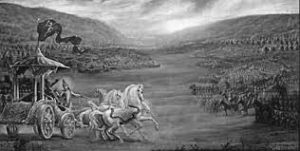Mahābhārata - Ahiṃsā
The trait of sattva does not mean non-activity or lack of valour. The same can be said of ahiṃsā too. We have seen earlier that ahiṃsā is one of the first pre-requisites for the practise of yoga. It is not sufficient merely staying away from violence but one must also show compassion. That is the very first ātma-guṇa laid out by the author of the dharma-sūtras (see Gautama-dharma-sūtra). But the Mahābhārata is a story of war; where there is war, there will be killings; in eighteen days, eighteen akṣauhiṇis were decimated. A red river of blood flowed. When Arjuna says that he will not fight, Kṛṣṇa replies – “This attempt of yours is useless. Your fundamental nature will make you fight. If you do not fight, you will get a bad name and incur sin.” Thus, using various lines of reasoning, Kṛṣṇa coaxes Arjuna to fight the war. Even a person like Dharmarāja fought the war. He killed as many people as he could and as a result, what he got was vīra-svarga (place in the heaven reserved for the brave).
While in the forest, they hunted animals and ate meat. Not only them, but everyone, of all social background, was a meat-eater. Once, the animals of Dvaitavana came to Dharmarāja in his dream and begged him not to kill them; his heart did not melt at those words to the extent that he turned vegetarian. He merely took his family members to a different forest. The killing of animals was a part of yajñas and yāgas. ‘Dharma’vyādha was butcher, but with time, the mindset for non-violence and compassion increased. Meat eating reduced. This is also one of the reasons why the yajñas and yāgas reduced. None need to feel bad about this change, nor feel proud about it. There are many non-vegetarians in India and abroad. Even so, it is virtue to have given up meat eating. It is natural for man to take to drinking alcohol and eating meat; therefore, those are not wrong; but, giving up of these practises is certainly a virtue – thus says Manu.
न मांसभक्षणे दोषो
न मद्ये न तु मैथुने।
प्रवृत्तिरेषा भूतानां
निवृत्तिस्तु महाफला॥
(It is but natural for humans to eat meat, consume alcohol and engage in sex. This is not wrong. However, letting go of these is a great virtue.)
– Manusmṛti 5.56
Ahiṃsā is like gold; pure gold cannot be turned into a coin; it will be of no practical use. It needs to be mixed with robust and firm copper. Similarly, in a king, a certain amount of firmness is essential. It is only the Rāja-daṇḍa (the rule of the king) that protects dharma, artha, and kāma. It is only for the fear of punishment that people abstain from crime. For bringing the evil under control, a certain amount of cruelty and violence are required. Such violence is not violence in the real sense, but it is for strengthening the foundations of dharma. Even in the ideal kingdom of Rāma, killing of rākṣasas took place. It is certainly violence to put at stake the lives of the youth of the country for selfish ends and not the practise of cruelty and violence for the sake of maintaining order.
Therefore, the intent behind an act takes precedence over the actual act of violence. Further, the causes of violence – greed, pride, lust, anger and others should be given up. When a surgeon operates on the body and saves a life – that does not count as violence; it is not a sin. However, if a criminal uses the same instrument and kills someone, that is a sin; therefore, in acts that seem violent, it is important to raise the questions of Who, Why, and How – and provide answers for them. If not, ahiṃsā remains an eye-wash and does not benefit anyone. Even if we wish to milk a cow, a certain amount of violence is involved.
“The emphasis on violence, here and elsewhere, is interesting; for no obvious contradiction appears to be noticed between this and fighting for a righteous cause. The whole epic centres around a great war. Evidently the conception of Ahimsa, non-violence, had a great deal to do with motive, the absence of the violent mental approach, self-discipline and control of anger and hatred, rather than physical abstention from violent action, when this became necessary and inevitable.” – Discovery of India, p. 113
Ahiṃsā means absence of cruelty. It is not lack of vigour; it is not tamas (lethargy, indifference); it doesn’t mean unconditional compromise; the more we bend to the whims of others, the more we get buried under. A spineless and helpless individual ends up there, after all. But a person who is strong and has the will to survive will certainly fight life’s battles. The reason being that man craves for happiness, not for death. If we bend to evil forces at all times, we will only get strangled in the end (one might recall the story of Old Man and the Sea by Ernest Hemingway). The more we submit to a greedy person, the more he will exploit us. However a good a person may be, there is always a limit for his tolerance and his exercise of non-violence. Thus, at some level, violence is essential. This is how wars have taken place. When two parties battle each other, each one claims to be fighting for justice, for the establishment of dharma, and to save the civilization; but it only results in a bloodbath of the entire nation, loss of property and wealth, barren lands, famines, despair, and helplessness.
In the past, King Pāṇḍu ruled over all the kingdoms; after his death, the Pāṇḍavas merely asked for half the kingdom – only the portions that he had won over in addition to what existed before his time. Then they reduced their request to five villages. But in response, the Kuru prince said that he would not part with even the space occupied by the tip of a needle. What should the Pāṇḍavas do? They would have to return to the forest; and that is exactly what Duryodhana wanted. His lowly mentality and adharma-mindset does not end there. He is not content merely with his happiness. He also desires the unhappiness of his neighbour. He seems to be more enthusiastic looking at their pathetic state rather than enjoying his comforts. It is for this reason that Duryodhana goes to the forest under the pretext of a Ghoṣayātrā (roughly translated as - ghoṣa = cowherd colony, yātra = trip) with an exorbitant display of his wealth and marches in front of the Pāṇḍavas, who are residing there. Duryodhana loses faces at the hands of the Gāndharva king. It is only Arjuna’s courage and Yudhiṣṭhira’s compassion that allowed him to live; disgraced, he returned home. However, Yudhiṣṭhira’s nobility, compassion, and goodwill were akin to pouring water into a cauldron of boiling oil. This episode only agitated Duryodhana further; his hatred for the Pāṇḍavas only became more intense. In the end, his loss was due to such display of bad character, and due to his inherent failings like jealousy, intolerance, deception, hatred, and pettiness. [Ghoṣayātrā was a pompous trip made by Duryodhana and the others under the pretext of visiting the cowherd colony to do a census, but with the ulterior motive of a vulgar display of their glory]
Duryodhana’s plans failed. Victory did not come to greed and deceit, nor to betrayal and hatred, nor to evil machinations and sadism, and neither to injustice and atrocity; what won in the end was justice and dharma; not the army of eleven akṣauhiṇis but the one with seven; not to the armies that fought the war but to the charioteer who did not – this Duryodhana finally realized. This is the great teaching of the Mahābhārata to kings and statesmen.
To be continued.
Thanks to Śatāvadhāni Dr. R Ganesh for his astute feedback.













































